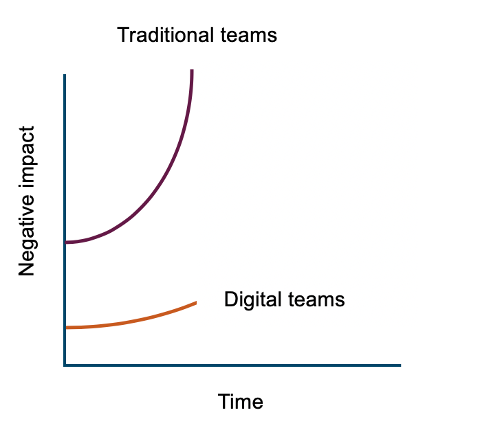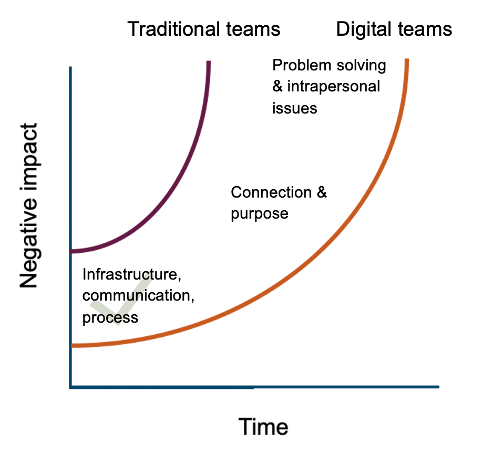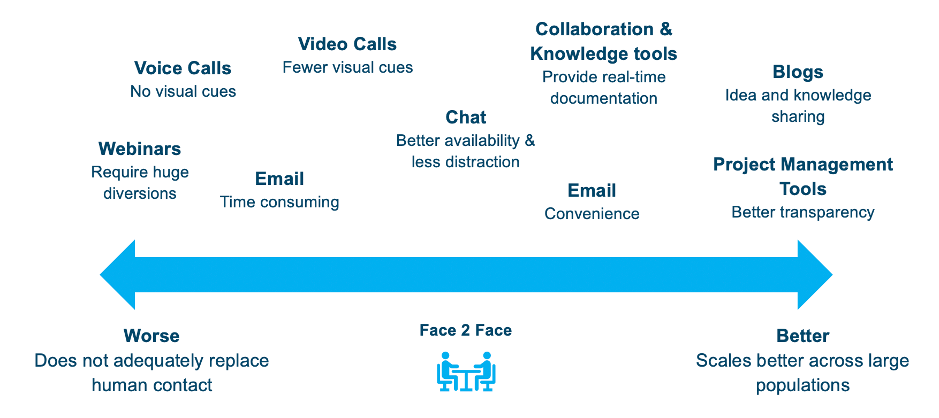Remote working can make us more productive than ever before
The biggest ever experiment in remote working not only helps flatten the curve, but prepares us for the future at the same time
Digitalization gives us the tools and methods to minimize the disruption of remote working, and by addressing the broader challenges we can use this opportunity to become even better positioned for the future
COVID-19 has created multiple challenges across our work and private lives, including a completely unplanned mass experiment in remote working. Many have struggled with the implication of having one of our fundamental business tools – the office – taken away, in terms of basic infrastructure, in terms of management attitude, and in terms of having the basic transparency and processes in place that allow us to coordinate when we are apart.
We need to be fully engaged in this experiment – not just to see us through the coming months, but for the world that will come after. After restrictions were lifted in China Microsoft was still seeing double the pre-COVID-19 usage of their Teams collaboration platform, and its use in China continues to grow. Few doubt that future work has changed suddenly and irrevocably.
Index
Adapting to challenges
Many teams have adapted to the new reality will little or no impact on their daily work. In our own case, investments we have made over the last years in adopting better tools to support our work and communication and in agile processes that create smoother communication flow and promote better understanding across projects have enabled us to continue business as usual with virtually no disruption.

So far, so good. But we need to look at this over the long term, because in many ways we have not flattened the curve, we’ve only shifted it. There are two reasons behind this – the need to provide teams with purpose and connection, and the need to be able to not just work, but solve problems together from a distance.
How can we mitigate these issues, and how can we use this to create additional benefits at the same time that will serve us over the long haul?

Purpose and Connection
Executing short term and well-known tasks – which make up a large part of most people’s day – is never a problem. The challenge comes when we need to make decisions.
Because decisions are usually swayed by direction, by biases, by outside opinions, and by former experiences. Unchecked, the direction of different decisions made by different individuals can quickly diverge leading to the familiar problems of misaligned projects, conflicts of opinion, and delayed progress due to constant re-validation or missteps.
But when a team has a clearly understood purpose, and a mission and strategy that is well understood and internalized – which is difficult to do, but definitely possible – then decisions become easier because they are strongly influenced by the purpose, or they can quickly be validated against the purpose. Conflicts are reduced, people pull in the same direction. Less guidance is needed, more autonomy is possible.
Autonomy is important because of the added advantage that even in normal situations a team that can function mostly autonomously is likely to be faster and more productive, in addition to the fact that numerous surveys rank autonomy as the most motivating aspect of any job environment.
Purpose also creates connection by binding the team to a common goal and helping to establish trust. The connection is not only psychologically important in these times, but its ability to create trust in what others in the team are doing and what they are thinking is increasingly important when we lack the usual daily clues from working physically together.
Missing trust is always one of the first signs of a dysfunctional or low performing team. Being able to create and then articulate a strong common purpose that enables a team to feel connected has long term benefits to going way beyond remote working.
Having a purpose-driven connection within the team also helps create more active communication online. If you’ve ever experienced dead chat channels or other lackluster online communication, it’s usually because there is no sense of connection and purpose among the team. Why share when there is just no point?
But how do we create that, and how do we do that remotely? There are many ways to put a strategy together and there has certainly been way too much written about that before me. So perhaps the simplest way to approach the challenge is to reverse engineer the statements that I have made above. – Think about what we want to achieve in terms of guidance that helps align decisions and common goals that the team must achieve. If a strategy can be articulated along those lines in a clear and practical sense then it potentially becomes far more useful and practicable.
Remote Problem-Solving
At some point, every project reaches a moment where somebody says “I think we need a workshop” where we need to come together to figure things out and reset issues.
We tend to do this using face to face meetings because it is the richest model of communication that we have available to us. But is it really the richest, or just the most natural for us? Does the fact that we are often more comfortable when talking directly to other humans mask the fact that f2f is very transient and often very prone to misunderstandings?
The probability is that large scale meetings are going to be difficult to do for quite some time, making right now a good time to think more about how we can improve on the limits of f2f instead of worrying about not having it.

While phone calls or video calls are definitely not quite the real thing, at the same time tools that help us share knowledge (wikis, or project management tools such as MS Planner or Trello) and tools that let us communicate asynchronously (such as Slack or MS Teams), and other post-email tools such as blogs that let us share and comment ideas all help create a richer spread of knowledge across the team.
For example, transparency of progress is one of the biggest hurdles that first-time remote teams face. Yet tools such as burn-down charts provide immensely better progress transparency than most teams have ever had before.
The trick is to get disciplined and structured about using them and to build them into the daily workflow. Many will protest about the time it takes to do this while ignoring the huge time penalty that comes from a lack of coordination without it. It’s worth asking a few simple questions about how much time is wasted through work that never gets used, re-work that is required due to misunderstandings, time spent waiting for decisions, or missed deadlines from other teams. Structured sharing of information by forming habits with a richer digital toolset pays off.
In truth, the points above relate to avoiding rather than solving problems, and they shift the curve instead of flattening it. The reality is that it will always be difficult to solve difficult problems from afar, but richer tools help us combine our collective intelligence in a way that definitely helps.
Becoming even better for the future
None of the challenges here are exclusive to remote working. Every team struggles at one time or another with differences over goals, lack of trust, or the ability to solve particularly knotty problems.
But working remotely is forcing us to challenge these problems and the way that we deal with them more intensively. The Coronavirus crisis is not so much creating changes in our workplaces, but accelerating trends that were already happening. Change that could have taken 10 years or more will now happen far more quickly. So it is time to prepare for that.
So, if we look forward to the post-crisis world, many of the lessons that we will have learned will continue to pay back. A team that is better aligned, more communicative, and better positioned to solve problems will be in better shape to solve the other challenges in the future where change will only continue to accelerate.

Comments are closed.